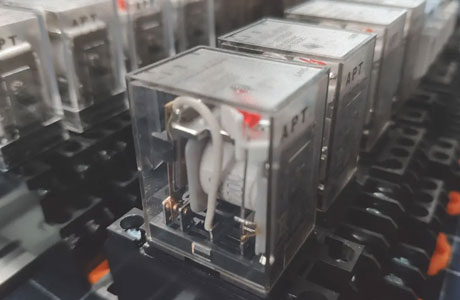Key Takeaway
The primary function of a relay is to control the flow of electricity in a circuit. Relays protect electrical systems from high voltage or current, ensuring safe operation of connected equipment. They act as switches that open or close circuits based on an external signal. This makes them essential in various applications, including commercial, industrial, and home use. Relays provide isolation between the control circuit and the load, enhancing safety and reliability in electrical systems.
Switching Mechanism
The fundamental function of a relay is to act as a switching mechanism. When a control signal activates the relay, it opens or closes its contacts to connect or disconnect a load. This switching mechanism allows low-power circuits to control high-power loads without direct electrical contact. For example, in industrial automation, a small control signal from a PLC (Programmable Logic Controller) can activate a relay to switch on a high-power motor. This capability to switch large currents and voltages with a small input signal makes relays vital for managing electrical loads safely and efficiently.

Control Circuits
Relays are crucial in control circuits, enabling complex control logic to manage electrical systems efficiently. They can be used to implement various control functions such as latching, timing, and sequencing. In a control circuit, relays interact with sensors, switches, and other control devices to execute specific actions based on predefined conditions. For instance, in a home automation system, relays can control lighting, heating, and security systems based on inputs from sensors and timers. This integration allows for the automation of processes, enhancing the functionality and efficiency of electrical systems.
For example, consider a scenario where a temperature sensor detects that a room has become too cold. The sensor sends a signal to a relay, which then activates the heating system. Similarly, in industrial applications, relays can sequence operations such as starting and stopping motors or machinery based on a set schedule or condition. This ability to integrate seamlessly with control circuits makes relays indispensable in both residential and industrial applications, providing flexibility, reliability, and precision in managing various processes.
Protection Mechanisms
Another important function of relays is to provide protection mechanisms for electrical circuits. Relays can safeguard circuits from faults such as overcurrent, overvoltage, and short circuits. Protective relays are designed to detect abnormal conditions and disconnect the affected part of the circuit to prevent damage. For example, in power distribution systems, protective relays can isolate a faulty section of the network to prevent widespread outages and equipment damage.
Imagine a scenario where a sudden surge in current threatens to damage a sensitive piece of equipment. A protective relay can quickly detect this anomaly and cut off the power supply, thus preventing potential harm. This functionality is critical in ensuring the safety and reliability of electrical systems, especially in environments where consistent performance is crucial. By incorporating relays into protection schemes, engineers can enhance the operational integrity of electrical systems, ensuring they operate within safe parameters and minimizing the risk of equipment failure and downtime. This proactive approach to fault management underscores the importance of relays in maintaining the health and efficiency of electrical networks.
Signal Amplification
Relays can amplify signals, allowing low-power control signals to manage high-power loads. This means a small input current can activate a relay, which then switches a much larger current in the load circuit. This amplification capability is particularly useful in scenarios where control systems must operate high-power devices without exerting significant power themselves. For instance, in automotive applications, a small signal from the vehicle’s control unit can use a relay to activate the starter motor, which requires a much higher current. By amplifying signals, relays enable efficient and effective control of high-power systems using low-power signals.
This capability is not just limited to automotive applications but extends to various industrial and residential uses. In industrial settings, relays can control heavy machinery with minimal input from control circuits, thereby safeguarding delicate components from high power. In residential settings, relays can help manage electrical appliances, providing a bridge between low-power control systems and high-power devices. This amplification ensures that control systems remain safe and efficient, highlighting the critical role of relays in modern electrical engineering.
Remote Control Operations
Relays facilitate remote control operations by allowing control signals to be sent over long distances to operate devices. This function is crucial in applications where the control point is far from the load. For example, in telecommunication systems, relays can be used to route signals and control equipment located far from the control center. Similarly, in industrial settings, relays enable operators to control machinery and processes from a central location. This capability not only improves operational efficiency but also enhances safety by reducing the need for manual intervention in hazardous environments.
In practical terms, this means an operator can control heavy machinery or complex systems from a safe distance, minimizing the risk of accidents. For instance, in a factory, an operator can use a relay to start or stop machinery from a control room, ensuring they are not exposed to the potential hazards of the factory floor. In telecommunications, relays can manage data flow and signal routing, allowing for efficient and reliable communication across vast distances. This remote control capability underscores the versatility and essential nature of relays in ensuring both operational efficiency and safety in various industries.
Conclusion
Relays perform several critical functions, including acting as switching mechanisms, integrating into control circuits, providing protection mechanisms, amplifying signals, and enabling remote control operations. These functions make relays indispensable in various applications, from industrial automation and home automation to telecommunications and automotive systems. For newly joined engineers, understanding these functions is crucial for designing and maintaining efficient and reliable electrical systems. By leveraging the capabilities of relays, engineers can enhance the performance, safety, and versatility of their projects, ensuring success in a wide range of applications.
